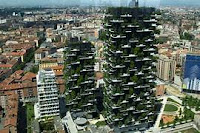The Rise of Biophilic Design: Integrating Nature into Modern Architecture QP
Introduction
In an era where urbanization is on the rise, there's a growing disconnect between humans and the natural environment. This separation has led to increased stress, reduced well-being, and a greater environmental footprint. However, a transformative architectural trend known as "biophilic design" is helping bridge this gap. This blog explores the rise of biophilic design, how it integrates nature into modern architecture, and the profound benefits it brings to our lives and the planet.
Understanding Biophilic DesignDefinition and Origins:
Biophilic design stems from the concept of biophilia, a term popularized by biologist E.O. Wilson, which suggests that humans have an innate connection to nature. This design approach emphasizes incorporating natural elements into the built environment to enhance our physical and mental well-being.
Key Principles:
.Direct Connection to Nature: Incorporating natural light, fresh air, water features, and plants directly into the architecture.
.Natural Materials: Using wood, stone, and other materials that evoke a sense of nature.
.Organic Forms and Patterns: Integrating shapes and patterns found in nature, like curves, fractals, and biomorphic forms.
.Spatial Design: Creating spaces that mimic natural habitats, providing refuge, mystery, and exploration.
Benefits of Biophilic Design
Improved Health and Well-being:
Studies have shown that exposure to natural elements in living and working environments can reduce stress, lower blood pressure, and improve cognitive function. Hospitals that incorporate biophilic design see faster recovery times among patients, while schools and offices report increased productivity and satisfaction.
Sustainability and Environmental Impact:
Biophilic design often goes hand-in-hand with sustainable practices. By integrating green roofs, living walls, and natural ventilation, buildings can reduce their energy consumption and carbon footprint. This approach not only benefits the occupants but also contributes to broader environmental goals.
Economic Advantages:
Though the initial cost of biophilic design elements can be higher, the long-term benefits often outweigh these costs. Buildings with biophilic features tend to have higher property values and can command premium rents. Additionally, the increased productivity and reduced absenteeism in biophilic workspaces can lead to significant financial gains for businesses.
Case Studies and Examples
The Amazon Spheres (Seattle, USA):
A standout example of biophilic design, the Amazon Spheres are three connected glass domes housing over 40,000 plants from around the world. This workplace environment prioritizes employee well-being by providing a connection to nature in the heart of the city.
Bosco Verticale (Milan, Italy):
This pair of residential towers is renowned for its extensive vertical gardens, which not only beautify the urban skyline but also provide a natural habitat for birds and insects, improve air quality, and offer residents a unique connection to nature.
Changi Airport’s Jewel (Singapore):
A hub of biophilic design, Jewel Changi Airport features the world's tallest indoor waterfall surrounded by a lush forest, creating a tranquil, nature-immersed experience for travelers.
Implementing Biophilic Design in Everyday Spaces
Residential Spaces:
Homeowners can integrate biophilic principles by adding indoor plants, creating garden spaces, using natural materials for furniture and decor, and maximizing natural light.
Commercial and Office Spaces:
Companies can benefit from biophilic design by incorporating green walls, natural lighting, and open, airy layouts that encourage movement and creativity. These changes not only enhance employee well-being but also contribute to a more sustainable business model.
Urban Planning and Public Spaces:
Cities around the world are beginning to integrate biophilic design into public spaces, from green roofs on city buildings to the development of urban parks and pedestrian-friendly streetscapes.
Challenges and Considerations
While biophilic design offers numerous benefits, it also comes with challenges. These include higher upfront costs, the need for ongoing maintenance of natural elements, and the challenge of retrofitting existing structures. However, as awareness and demand for sustainable and health-conscious design grow, solutions to these challenges are increasingly being developed.
Conclusion
The rise of biophilic design marks a significant shift in how we think about architecture and urban planning. By prioritizing our connection to nature, this design philosophy not only enhances our well-being but also promotes sustainability and economic vitality. As we move towards a more nature-integrated future, biophilic design will play a crucial role in shaping the spaces where we live, work, and play.Encouraging architects, developers, and homeowners to embrace this approach could lead to healthier, happier, and more sustainable communities worldwide.
BLOG BY;AMEEN SAHBAN



















![Terry Farrell [ British architect]](https://blogger.googleusercontent.com/img/b/R29vZ2xl/AVvXsEgF5Bc7-F6oyGHwVlcJfUVoN9PAph8ZIAQAVTMDZ0oOX0kIENEGN84Arj8wxKS666_yV2hRHMM4zlJ5gCJFBA1ttvrGBPrCNY0tZWfcuPl0aolt_szKpBjWtbLYutI4ivHBLrzZkj-wEk_l_1paoEEVkgnzCt7yvpHoDkhm63TxHxL45GUgV2OZVkwLYkWG/w100/11e81b6d-862f-4a23-a2d0-950d22063de0.png)



0 Comments